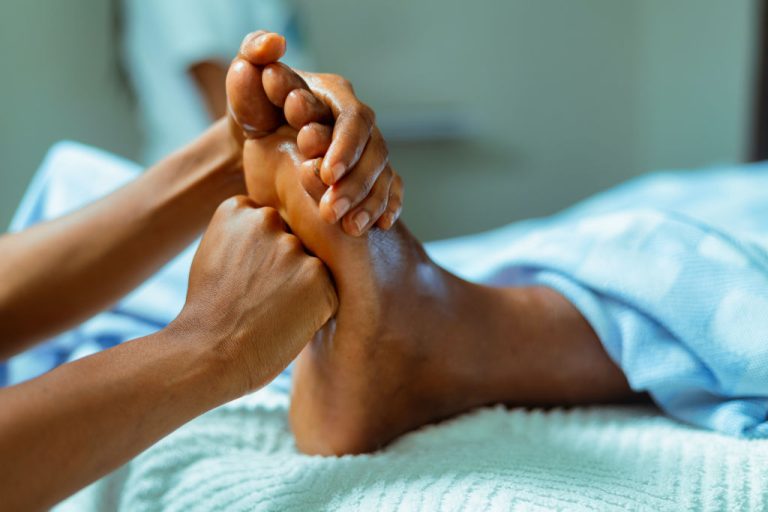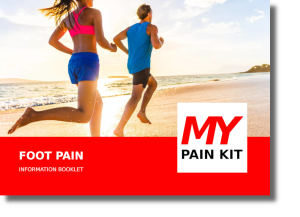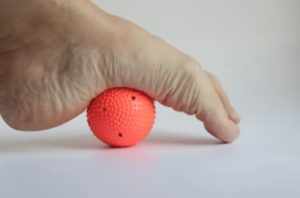If you find yourself getting up in the morning, and when you put your foot on the ground, you feel a sharp pain in the bottom of your foot – you could have Plantar Fasciitis!
In This Article:
Does Morning Foot Pain Sound Familiar?
If, every morning, while getting out of bed, the moment you put your foot down – the pain starts. It can be so severe that you might have to limp to the toilet!
The pain is sharp and intense in the sole of your foot and heel. After walking for a while, it then starts to feel a little better, as you hobble around the house.
Don’t worry, there is a lot that can be done to reduce your pain and correct this painful condition.
What Exactly Is Plantar Fasciitis?
The Plantar Fascia is a tendon-like structure at the bottom of your foot running from your heel to the base of the toes. It is supported by muscles in the arch of the foot and plays a major role in how your foot functions, through weight bearing and movement. When this fascia becomes inflamed it is called Plantar Fasciitis.
The Pain is under the foot most commonly near the heel and under the arch of the foot (usually the inside part of the foot). It usually feels worse in the morning but tends to improve with movement throughout the day.
Over time Plantar Fasciitis can aggravate Knee Pain, Hip Pain and Low-Back Pain.
What Are The Fastest Ways To Fix Heel Pain?
We need to avoid the quick fix, gimmick treatments and address the underlying causes:1. Pain Relief Isn’t A Solution
We don’t recommend using Pain Relief as a first resort. It really should only be used if you have exhausted all other avenues of treatment.
There is no easy fix for this problem – it will come down to your ability to get the correct exercises, stretches and ultimately strength routine to help your foot recover.
2. Masking Pain Can Cause Damage
With Plantar Fasciitis being an inflammatory issue, if you use painkillers to mask the pain, you will then use your foot more – which could make the situation worse.
Even a small change like your footwear would be better than using painkillers – at least you’re ticking a potential cause off the list!
3. Orthotics?
Because Plantar Fasciitis means the structures of the foot are very sensitive but rarely damaged, the main way to treat this is to bring down the inflammation.
People tend to look to Orthotics but they are not always necessary and very expensive. We would recommend the use of Orthotics only as a later measure, after other treatment options have been exhausted.
4. Hot / Cold Therapy
This IS something that we do recommend (and include in our Pain Kit). Hot and Cold Therapy are included in each of our Pain Kits!
Normally with inflammation you should be using Cold Therapy to bring down the swelling and pain, before switching to the treatment phase – where you can use heat therapy to increase blood flow and speed up the healing of your foot.

What’s The Most Common Cause Of Foot Pain?
One of the major causes of Plantar Fasciitis is obesity and a sedentary lifestyle. We tend to see more overweight present with this problem in our clinics – and lifestyle is a major factor.
Our bodies are meant to move, and with more people sitting all day in desk jobs, becoming less fit as each year goes by – it all leads to a surge in these types of issues.
Treating Plantar Fasciitis Properly
There are multiple ways to treat this condition – and it starts with getting a proper diagnosis from your trained medical professional. Don’t self-diagnose!
Regular Massage, Movement & Stretching
You must be prepared to commit to a regular habit of Massage and Stretching to help your Plantar Fasciitis. Also – if your pain is particularly bad, you can use Cold Therapy to bring down the inflammation and hopefully reduce pain.
Strength Exercises For Foot Posture
Only when your foot is feeling much better should you be starting the Strength Exercises portion of your rehabilitation plan. Strengthening the arch of your foot, and your “Foot Posture” will help to prevent the painful issue coming back!
My Pain Kit – For Plantar Fasciitis
Different healthcare practitioners prescribe different exercise plans, but most agree on a combination of movement, stretching and strengthening exercises are best for plantar fasciitis recovery. At mypainkit.com we have a targeted six step rehab programme for plantar fasciitis with specific tools to carry out the program. The painkit will contain hot and cold packs, foot-roller, resistance bands and a detailed exercise plan of movement, stretching and strengthening specific to plantar fasciitis.
Frequently Asked Questions:
Sometimes you could be lucky – making a small change like different shoes can make the pain go away.
But normally you will need to work on your condition yourself to deal with the underlying issue.
Plantar Fasciitis is an inflammatory issue, so bringing down the swelling is a great place to start.
We recommend the following strategy:
- Heat Therapy
- Massage
- Movement
- Stretch Exercises
- Strength Exercises
- Cold Therapy
- Bracing
This will get you started, and gradually restore your range of movement. Always consult a doctor.
Yes, resting can help the pain subside in the initial states of Plantar Fasciitis. But ironically, too much rest can make you more susceptible.
Focus on getting the inflammation down with a Cold Pack and specific exercises can then help you perform a full recovery.
If you are on your feet all day, are not overweight and are wearing the correct footwear, you probably won’t develop Plantar Fasciitis.
This is the irony. You’re much more likely to develop plantar fasciitis if you spend more time sitting, and consequently are not getting as much exercise as you should.
Being overweight is also a major risk factor for developing the problem.







